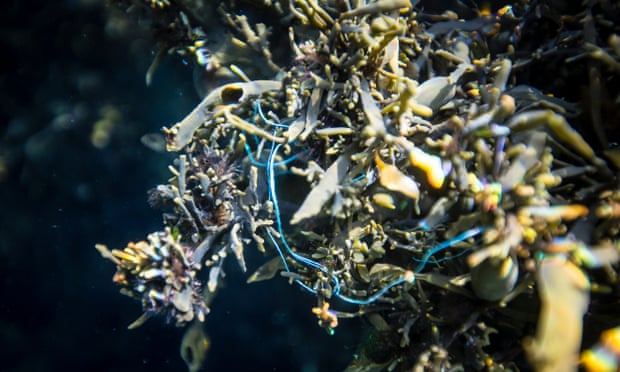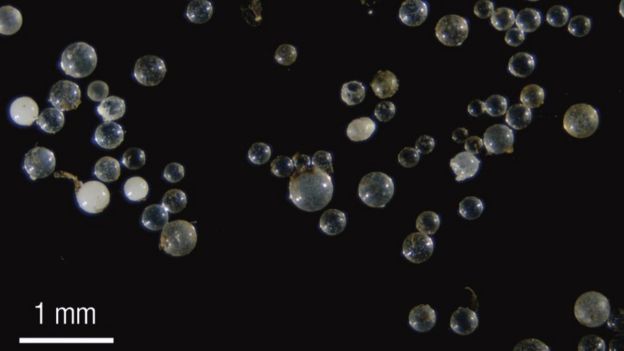From The Guardian by Damian Carrington
A study reveals highest microplastic pollution levels ever recorded in a river in Manchester, UK and shows that billions of particles flooded into the sea from rivers in the area in just one year
Plastic pollution is known to harm marine life and can enter the human food chain via our food and water.
Photograph: Will Rose/Greenpeace
The number of tiny plastic pieces polluting the world’s oceans is vastly greater than thought, new research indicates.
The work reveals the highest microplastic pollution yet discovered anywhere in the world in a river near Manchester in the UK.
It also shows that the major floods in the area in 2015-16 flushed more than 40bn pieces of microplastic into the sea.
The surge of such a vast amount of microplastic from one small river catchment in a single event led the scientists to conclude that the current estimate for the number of particles in the ocean – five trillion – is a major underestimate.
Microplastics include broken-down plastic waste, synthetic fibres and beads found in personal hygiene products.
They are known to harm marine life, which mistake them for food, and can be consumed by humans too via seafood, tap water or other food.
The risk to people is still not known, but there are concerns that microplastics can accumulate toxic chemicals and that the tiniest could enter the bloodstream.
“Given their pervasive and persistent nature, microplastics have become a global environmental concern and a potential risk to human populations,” said Rachel Hurley from the University of Manchester and colleagues in their report, published in Nature Geoscience.
The River Tame, near Manchester, has the highest microplastic pollution yet discovered anywhere in the world
Microplastics concentration in sediments and surface water
The team analysed sediments in 10 rivers within about 20km of Manchester and all but one of the 40 sites showed microplastic contamination.
After the winter floods of 2015-16, they took new samples and found that 70% of the microplastics had been swept away, a total of 43bn particles or 850kg.
Of those, about 17bn would float in sea water.
“This is a small to medium sized catchment in the north of England, it is one flood event, it is just one year – there is no way that [5tn global] estimate is right,” said Hurley.
The researchers said total microplastic pollution in the world’s oceans “must be far higher”.
The worst hotspot, on the River Tame, had more than 500,000 microplastic particles per square metre in the top 10cm of river bed.
This is the worst concentration ever reported and 50% more than the previous record, in beach sediments from South Korea.
But Hurley said there may well be worse places yet to me measured: “We don’t have much data for huge rivers in the global south, which may have so much more plastic in.”
Plastic microbeads, like these recovered from the River Mersey,
are now banned in cosmetics in the UK
“There is so much effort going into the marine side of the microplastic problem but this research shows it is really originating upstream in river catchments,” she said.
“We need to control those sources to even begin to clean up the oceans.”
About a third of microplastics found by the team before the flooding were microbeads, tiny spheres used in personal care products and banned in the UK in January.
This high proportion surprised the scientists, who said the beads may well also derive from industrial uses, which are not covered by the ban.
Erik van Sebille, at Utrecht University in the Netherlands and and not part of the research team, said the work does support a much higher estimate of global microplastic pollution in the oceans: “I’m not surprised by that conclusion.
In 2015, we found that 99% of all plastic in the ocean is not on the surface anymore.
The problem is that we don’t know where that 99% of plastic is.
Is it on beaches, the seafloor, in marine organisms? Before we can start thinking about cleaning up the plastic, we’ll first need to know how it’s distributed.”
Anne Marie Mahon, at the Galway-Mayo Institute of Technology in Ireland and also not part of the research team, said: “I am actually glad to see the estimate going up a bit, just to show there is this huge contribution coming from the freshwater system.” However, she cautioned that not all the microplastics shown in the study to be flushed out by the floods necessarily entered the sea – some may have been washed over the floodplain instead.
“It is very difficult to tell how this plastic may be affecting us,” Hurley said.
“But they definitely do enter our bodies.
The missing gap is we need to know if we are getting contaminants inside us as a result of plastic particles.”
The smallest particles that could be analysed in the new research were 63 microns, roughly the width of a human hair.
But much smaller plastic particles will exist, and Hurley said: “It is the really small stuff we get worried about, as they can get through the membranes in the gut and in the bloodstream – that is the real fear.”
Links :
- The Guardian : Plastic fibres found in tap water around the world, study reveals
- BBC : Microplastics are 'littering' riverbeds / Microplastics pollute most remote and uncharted areas of the ocean
- DailyMail : Toxic microplastics are being flushed into our oceans far faster than thought due to the flooding of urban rivers, warn scientists
- Phys : Flash floods found to send massive amount of microplastics from rivers to the sea
- IFLScience : Krill Can Digest Microplastics Into Ever Smaller Pieces, But That Might Not Be Such A Good Thing
- Stuff : Efforts to reduce plastic in seas 'meaningless' without knowing where it is from




NYTimes : Cracking Down on Plastics
ReplyDelete